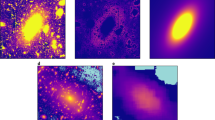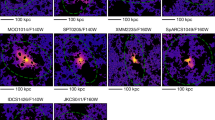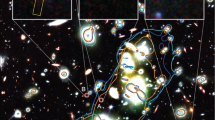Abstract
PHOTOGRAPHS taken with the UK 48-inch Schmidt Telescope at Siding Spring, Australia using hypersensitised Kodak IIIaJ emulsions, record objects as faint as magnitude 23 in exposures of an hour. Most galaxies on the photographs are very faint and at, say 22 mag probably have redshifts Z ∼ 0.5. At such large redshifts the K term is responsible for considerable reddening (B−V) ≃ + 2 mag and it may perhaps not be expected that such blue sensitive emulsions would show much increase in the number of faint galaxies recorded as the limiting magnitude increases beyond about 21 mag. The number of objects does, however, seem to continue to increase significantly with limiting blue magnitude and the question therefore arises as to whether or not a substantial number of faint images are blue and if so, what objects do they represent and how are they distributed ?
This is a preview of subscription content, access via your institution
Access options
Similar content being viewed by others
References
Dodd, R. J., Morgan, D. H., Nandy, K., Reddish, V. C., and Seddon, H., Mon. Not. R. astr. Soc., 171, 329 (1975).
Author information
Authors and Affiliations
Rights and permissions
About this article
Cite this article
HAWKINS, M., REDDISH, V. Clustering of faint blue objects. Nature 257, 772–773 (1975). https://doi.org/10.1038/257772a0
Received:
Accepted:
Issue Date:
DOI: https://doi.org/10.1038/257772a0
Comments
By submitting a comment you agree to abide by our Terms and Community Guidelines. If you find something abusive or that does not comply with our terms or guidelines please flag it as inappropriate.



